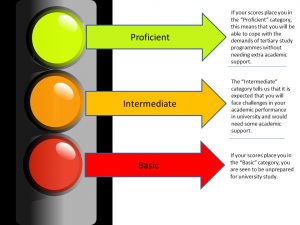What is the purpose of the NBTs?
The purpose of the NBT is four-fold:
- To assess entry-level academic and quantitative literacy and mathematics proficiency of students;
- To assess the relationship between entry level proficiencies and school-level exit outcomes;
- To provide a service to HE institutions requiring additional information in the admission and placement of students; and
- To inform the nature of foundation courses and curriculum responsiveness.
Why were the NBTs introduced?
The NBTs evolved from a suite of tests developed for alternative admissions in the 1980s:
- to identify students at risk in historically disadvantaged schools,
- to provide a basis for the development of appropriate courses and curricula,
- and to provide alternative access to university in the context of the then-racially fragmented South African Higher Education system.
In the 1990s, a further aim and use of the tests arose, which was to identify talented students whose Senior Certificate results did not make them eligible for selection to higher education studies.
In the 2000s, the National Senior Certificate was introduced and the Higher Education sector also became acutely aware of its own challenges in terms of low throughput and high drop-out rates.
Can you pass/fail the NBTs?
It is not possible to pass or fail the NBTs. The tests provide an indication of the readiness of candidates for the demands of higher education. NBT scores place candidates within a benchmark category and each university (and sometimes, different Faculties within the same university) use these in a slightly different ways to assist with decisions about admissions, placement and teaching and learning support. “Placement”, in this instance, refers to courses or curricula that are put in place to assist students who require academic support.
What does the ‘Benchmark’ in NBTs stand for?
The NBTs assess and evaluate student test scores according to criteria that are considered appropriate for degree, diploma and higher certificate study at institutions of higher learning. These criteria are reflected in the benchmark categories of performance for each of our domains (Academic Literacy, Quantitative Literacy, and Mathematics). The NBT benchmarks are revised every three years, as part of good testing practice.
How many benchmark categories are there and
-
what does each mean for students (parents and teachers)?
-
what does each mean for lecturers?
There are three benchmark categories for each of the three NBT tests which place a student’s test performance on the NBTs into: Proficient, Intermediate, and Basic categories. These benchmark categories provide information to universities about an applicant’s readiness for university and what kind of support the university needs to provide to students performing within these categories.
The benchmarks enable students, and their parents and teachers, to assess at a glance their readiness for university. Students should evaluate their scores against the admission requirements provided by the university to which they are applying and be prepared to work accordingly.
Through the NBT benchmarks, university lecturers are able to identify areas within the curriculum that need to be emphasised or amended in order to contribute to the academic success of their students.
What is a diagnostic test?
Educational diagnostic testing is a form of assessment that occurs before instruction begins. The purpose of administering diagnostic tests is to try to determine what students already know about the concepts and skills to be covered by instruction.
One of the strengths of the NBTs, and the way in which they can assist students and their university lecturers, is in their diagnostic ability. A recent report on the NBTs and the NSC by the Boston Consulting Group argues that the NBTs have strong diagnostic value “because of the way they are able to analyse students’ performance at a sub-domain level (i.e. performance within the broad constructs of ‘literacy’ and ‘mathematics’). The NSC simply cannot do this in its current form.”
Students, therefore, can use their NBT scores to request assistance or support for the academic areas in which their performance is weak, and their lecturers can use the information to develop teaching materials that respond directly to areas of weakness in their classes.
What are some of the best ways to address the retention and graduation challenges faced by SA HE?
The Council for Higher Education report of 2013, “A proposal for undergraduate curriculum reform in South Africa”, showed that graduation from a South African university in regulation time (three or four year degree) is at 27%, and that the student attrition rate stands at 40%.
The NBTs are more relevant now than ever before. Their strong diagnostic ability can be leveraged to address these challenges of low throughput (graduation) and high drop-out rates by ensuring that lecturers are armed with the knowledge they need to ensure that students are retained and can succeed at university.
What information is available to students (parents and teachers) regarding the NBTs?
While past papers of the NBTs are not distributed, the following resources are available from the NBT website to assist candidates who wish to prepare themselves for the tests:
- Exemplar questions for all three domains, available in English and Afrikaans.
- Educator’s booklets for all three domains, to assist in preparing learners, available in English, Afrikaans, Xhosa, and Zulu.
- A series of videos, aimed at educators, to assist them in preparing their learners for the tests.





